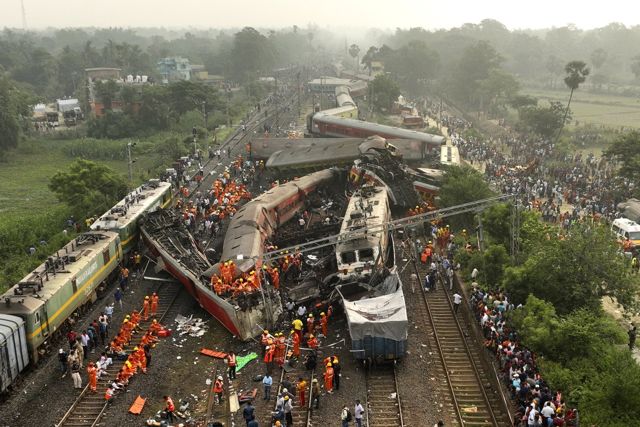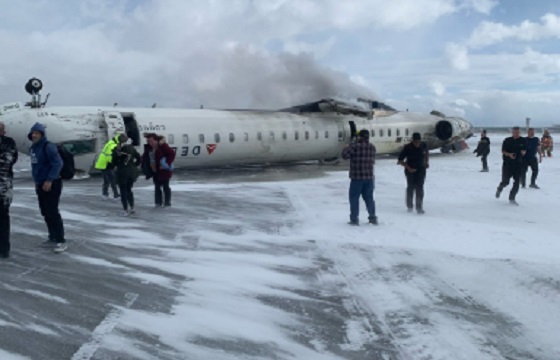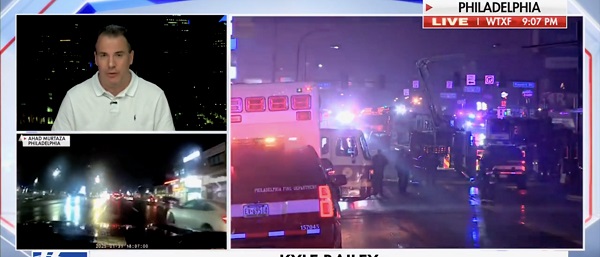Disaster
India train crash kills over 280, injures 900 in one of nation’s worst rail disasters

BALASORE, India (AP) — Rescuers found no more survivors in the overturned and mangled wreckage of two passenger trains that derailed in eastern India, killing more than 280 people and injuring hundreds in one of the country’s deadliest rail crashes in decades, officials said Saturday.
Chaotic scenes erupted on Friday night as rescuers climbed atop the wrecked trains to break open doors and windows using cutting torches.
The death toll rose steadily throughout the night. Scores of bodies, covered by white sheets, lay on the ground near the tracks while locals and rescuers raced to free the hundreds of people trapped in the rail cars under the twisted metal and broken glass. Army soldiers and air force helicopters joined the effort in Odisha state.
An Associated Press photographer saw bodies still entangled in a badly mangled coach, as rescuers struggled to retrieve them working under the oppressive heat with temperatures reaching up to 35 degree Celsius (96 degrees Fahrenheit).
“By 10 p.m. (on Friday) we were able to rescue the survivors. After that it was about picking up dead bodies,” Sudhanshu Sarangi, director of Odisha state’s fire and emergency department, told The Associated Press. “This is very, very tragic. I have never seen anything like this in my career.”
At least 280 bodies were recovered overnight and into Saturday morning, he said. About 900 people were injured and the cause was under investigation.
The accident occurred at a time when Prime Minister Narendra Modi is focussing on the modernization of the British colonial-era railroad network in India, which has become the world’s most populous country with 1.42 billion. Despite government efforts to improve rail safety, several hundred accidents occur every year on India’s railways, the largest train network under one management in the world.
Modi flew to the crash site and spent half an hour examining the relief effort and talking to rescue officials. He was seen giving instructions on the phone to officials in New Delhi.
He later visited a hospital where he walked around inquiring from doctors about the treatment being given to the injured, and spoke to some of them, moving from bed to bed in a ward.
Modi told reporters that it was a sad moment and he was feeling the pain of those who have suffered in the accident. He said the government would do its utmost to help them and strictly punish those found responsible.
Modi on Saturday was supposed to inaugurate a high-speed train connecting Goa and Mumbai that is equipped with a collision avoidance system. The event was canceled after Friday’s accident. The trains that derailed did not have that system.
Amitabh Sharma, a Railroad Ministry spokesperson, said the rescue work was near completion. Rail authorities will start removing the wreckage to repair the track and resume train operations, he said.
D.B. Shinde, a district administrator, said only five to six bodies remained trapped under a damaged coach and were difficult to recover.
“We have deployed a heavy crane. Once we take them out, the rescue work will be over,” Shinde said.
About 200 of the severely injured people were transferred to specialty hospitals in other cities in Odisha, said P.K. Jena, the state’s top administrative official. Another 200 were discharged after receiving medical care and the rest were being treated in local hospitals, he added. Scores of people also showed up to donate blood.
“The challenge now is identifying the bodies. Wherever the relatives are able to provide evidence, the bodies are handed over after autopsies. If not identified, maybe we have to go for a DNA test and other protocols,” he said.
Ten to 12 coaches of one train derailed, and debris from some of the mangled coaches fell onto a nearby track, according to Sharma. The debris was hit by another passenger train coming from the opposite direction, causing up to three coaches of the second train to also derail, he added.
A third train carrying freight was also involved, the Press Trust of India reported, but there was no immediate confirmation of that from railroad authorities. PTI said some of the derailed passenger coaches hit cars from the freight train.
The rescue operation was slowed because two train cars were pressed together by the impact of the accident, Jena said.
Officials said 1,200 rescuers worked with 115 ambulances, 50 buses and 45 mobile health units through the night. Saturday was declared as a day of mourning in Odisha.
Villagers said they rushed to the site to evacuate people after hearing a loud sound created by the train coaches going off the tracks.
“The local people really went out on a limb to help us. They not only helped in pulling out people, but retrieved our luggage and got us water,” PTI cited Rupam Banerjee, a survivor, as saying.
Passenger Vandana Kaleda said that people were falling on each other as her coach shook violently and veered off the tracks.
“As I stepped out of the washroom, suddenly the train tilted. I lost my balance. … Everything went topsy turvy. People started falling on each other and I was shocked and could not understand what happened. My mind stopped working,” she said.
Another survivor who did not give his name said he was sleeping when the impact woke him up. He said he saw other passengers with broken limbs and disfigured faces.
The collision involved two trains, the Coromandel Express traveling from Howrah in West Bengal state to Chennai in Tamil Nadu state and the Howrah Superfast Express traveling from Bengaluru in Karnataka to Howrah, officials said. It was not immediately clear which derailed first.
Ashwini Vaishnaw, India’s railway minister, said a high-level probe would be carried out. The political opposition criticized the government and called for Vaishnaw to resign.
In August 1995, two trains collided near New Delhi, killing 358 people in one of the worst train accidents in India.
In 2016, a passenger train slid off the tracks between the cities of Indore and Patna, killing 146 people.
Most train accidents are blamed on human error or outdated signaling equipment.
More than 12 million people ride 14,000 trains across India every day, traveling on 64,000 kilometers (40,000 miles) of track.
___
Sharma and Pathi reported from New Delhi. Associated Press journalist Chonchui Ngashangva in New Delhi contributed to this report.
Disaster
Delta flight crashes and flips upside-down at Toronto airport as 3 are left critically injured

Quick Hit:
A Delta Air Lines plane crash-landed and flipped upside-down at Toronto Pearson International Airport on Monday, leaving three passengers— including a child— critically injured. The incident occurred just before 3 p.m. after the aircraft took off from Minneapolis earlier in the day. Images from the scene show the plane severely damaged, with emergency crews rushing to assist passengers.
BREAKING- Toronto had a Delta flight flipped upside down. I got these photos from a friend on the plane. He’s okay. Minnesota to Toronto. pic.twitter.com/DeSoYAlsVo
— Kellie Meyer (@KellieMeyerNews) February 17, 2025
Key Details:
- The flight, identified as Delta Flight 4819, departed from Minneapolis at 11:47 a.m. before crash-landing in Toronto.
- At least eight people were reported injured, with three in critical condition, including a child and a man in his 60s.
- The aircraft, a Bombardier CRJ-900LR, was flipped upside-down on the runway, with one wing crumpled and the tail section partially sheared off.
Diving Deeper:
Emergency responders rushed to Toronto Pearson International Airport on Monday afternoon after Delta Flight 4819 suffered a crash landing, flipping upside-down on the snowy runway. Images from the scene depict a harrowing sight— the overturned aircraft smoldering, with dazed passengers evacuating.
According to CP24 News, eight people sustained injuries in the crash, three of whom were transported to separate hospitals in critical condition, including a pediatric patient. The Peel Regional Police confirmed that while most passengers made it out unharmed, authorities remained on-site to assess the full extent of the injuries and damage.
Passenger John Nelson captured the immediate aftermath on video, posting to Facebook: “We’re in Toronto. We just landed. Our plane crashed, it’s upside-down. Fire department is on site. Most people appear to be OK. We’re all getting off.” The footage shows emergency personnel navigating the snowy conditions to reach the aircraft and assist those on board.
Toronto Pearson officials confirmed on X (formerly Twitter) that all passengers and crew were accounted for, while the Association of Flight Attendants union stated that no fatalities had been reported. However, airport operations were briefly suspended in the wake of the incident, with arrivals and departures temporarily halted.
The crash comes after a weekend winter storm dumped nearly nine inches of snow on Toronto, prompting airport crews to work overnight to clear runways. Investigators will now seek to determine whether weather conditions or mechanical failure played a role in the crash. This marks the most serious commercial aviation incident since the January 29 collision at Ronald Reagan National Airport involving an Army Black Hawk helicopter and an American Airlines flight.
Daily Caller
‘Coming Down Like A Missile’: Former FAA Safety Rep Says Plane in Philadelphia Crash Appeared ‘100% Out of Control’

Kyle Bailey on “Hannity” discussing Philly plane crash [Screenshot/Fox News/”Hannity”]

From the Daily Caller News Foundation
By Hailey Gomez
Former Federal Aviation Administration (FAA) Safety Team representative Kyle Bailey said Friday evening on Fox News that the jet caught on camera crashing in northeastern Philadelphia appeared “100% out of control.”
Around 6:30 p.m. local time, videos surfaced showing a small jet crashing into a neighborhood in northeastern Philadelphia, with images and footage depicting the plane erupting into a fireball. The FAA confirmed the crash in a statement, identifying the aircraft as a Learjet 55 that had been departing from northeastern Philadelphia Airport en route to Springfield-Branson National Airport in Missouri.
On “Hannity,” Fox’s Sean Hannity began discussing the Learjet 55, adding that his pilot friends had described the aircraft as “a sports car in the air.” He then asked Bailey if this type of jet is different from the “average commuter jet.”
Dear Readers:
As a nonprofit, we are dependent on the generosity of our readers. Please consider making a small donation of any amount here. Thank you!
“That’s exactly right, Sean. You have to be ahead of that airplane at all times, or it will get control of you. That plane was doing in excess of 10,000 feet per minute rate of descent, and it didn’t even make it to 2,000 feet after takeoff,” Bailey said. “Right after takeoff, the controller was asking, calling for the airplane to respond. There was no response by the flight crew. There was no communication.”
“The controller was a little bit stumped in trying to make contact with the airplane, and that tells me that the pilot completely was consumed with whatever was going on, and from that rate of descent and from that airplane coming down like a missile, it looked like it could have potentially been at full power,” Bailey added. “It was just coming down there at a rate that really was unbelievable.”
WATCH:
Bailey went on to say that the explosion was likely massive due to the “large quantity of jet fuel,” adding that he believed there was probably nothing the pilot “could have done” to prevent the incident.
“So from taking off for a flight of the duration of where it was going, that probably was very closely, fully loaded with fuel. So that huge fireball that we saw is the result of a large quantity of jet fuel, and that big, almost like — for lack of a better term — like a nuclear-like explosion is probably the jet fuel reflecting off that cloud base,” Bailey said.
“That’s why it looks a little bit strange, but there is no doubt that the plane was 100% out of control, and there was probably nothing that pilot could have done,” Bailey added. “Not even a 10-second mayday came out of that radio back to the control tower.”
The plane was reportedly on a medical assignment with four crew members and two passengers aboard, according to 6ABC. During a press conference around 8:30 p.m., Democratic Philadelphia Mayor Cherelle Parker could not provide a fatality count. She instead asked residents “for prayers.”
The crash comes just days after a commercial plane collided with a military helicopter near Washington Reagan National Airport on Wednesday evening, killing all involved.
The incident is under investigation by the National Transportation Safety Board and FAA.
-

 2025 Federal Election2 days ago
2025 Federal Election2 days agoPoilievre Campaigning To Build A Canadian Economic Fortress
-

 Alberta12 hours ago
Alberta12 hours agoGovernments in Alberta should spur homebuilding amid population explosion
-

 Business11 hours ago
Business11 hours agoIt Took Trump To Get Canada Serious About Free Trade With Itself
-

 Automotive2 days ago
Automotive2 days agoCanadians’ Interest in Buying an EV Falls for Third Year in a Row
-

 2025 Federal Election2 days ago
2025 Federal Election2 days agoAs PM Poilievre would cancel summer holidays for MP’s so Ottawa can finally get back to work
-

 armed forces23 hours ago
armed forces23 hours agoYet another struggling soldier says Veteran Affairs Canada offered him euthanasia
-

 conflict22 hours ago
conflict22 hours agoWhy are the globalists so opposed to Trump’s efforts to make peace in Ukraine?
-

 2025 Federal Election16 hours ago
2025 Federal Election16 hours agoCarney’s budget is worse than Trudeau’s





